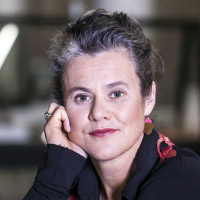Foreground, 18 April 2018
The City as Billboard: Fed Square, Apple and Brand Urbanism
Comment by Niels Wouters
Exploring opportunities for interactive media to enliven building facades and cultural spaces in the University of Melbourne’s new Innovation Precinct.

Buildings increasingly contain dynamic technologies that enable transformations in their physical appearance. The phenomenon is generally referred to as media architecture. With lights and screens, buildings become dynamic interfaces that are intrinsically adaptable and responsive. Depending on specific needs of occupants, buildings can rapidly change their appearance by changing screen contents, displaying new lighting patterns or providing new interaction opportunities. As such, media architecture provides a novel way for buildings to stand out, but also proves to be a popular medium to activate the surrounding public space.
In collaboration with Science Gallery Melbourne, this project will investigate the opportunities to integrate media architecture within the University’s new Innovation Precinct. Science Gallery Melbourne is a node of the award-winning International Science Gallery network which will be opening at the University of Melbourne in 2020. In a bid to future-proof its exhibition environment, Science Gallery Melbourne is looking at activating its indoor and outdoor spaces by embracing state-of-the-art technologies. The ambitions include the integration of a digitally augmented building facade and a series of immersive interior spaces.
This project actively explores the intersection between art and science. It presents unique opportunities to design natural user interface technologies that fulfil a permanent role within the future exhibition space of Science Gallery Melbourne. As one of the project outcomes, we will develop Biometric Mirror; a digital work that showcases technical state-of-the-art as well as an artistic work that stimulates reflection on broader themes such as privacy and ethics in public space.
This project will result in a comprehensive brief that outlines the specific media requirements for Science Gallery Melbourne. The brief will be based upon design research that addresses a wide range of questions on digital flexibility, cultural contribution, community inclusion, and architectural integration. By investigating such questions through the lens of architectural design and Human-Computer Interaction, the project will provide valuable insights that will inform the future of media architecture, especially in cultural contexts.
This project is a collaboration between the University of Melbourne’s Microsoft Research Centre for Social Natural User Interfaces (SocialNUI) and Science Gallery Melbourne.



Wouters, N., Claes, S. & Vande Moere, A. (2018) Hyperlocal Media Architecture: Displaying Societal Narratives in Contested Spaces. Media Architecture Biennale 2018, 13–16 November, Beijing, China. DOI: 10.1145/3284389.3284490
Wouters, N., Hunt, T., Dziemidowicz, O., Hiscock, R. & Vetere, F. (2018) Media Architecture in Knowledge and Innovation Districts: Designing a Canvas for Research, Culture and Collaboration. Media Architecture Biennale 2018, 13 – 16 November, Beijing, China. DOI: 10.1145/3284389.3284492
Foreground, 18 April 2018
Comment by Niels Wouters
CNN, 2 January 2018
Article by Niels Wouters
ABC Radio, 10 October 2017
Interview on ABC 1233 Newcastle. Audio not available.
The Conversation, 9 October 2017
An article by Niels Wouters.